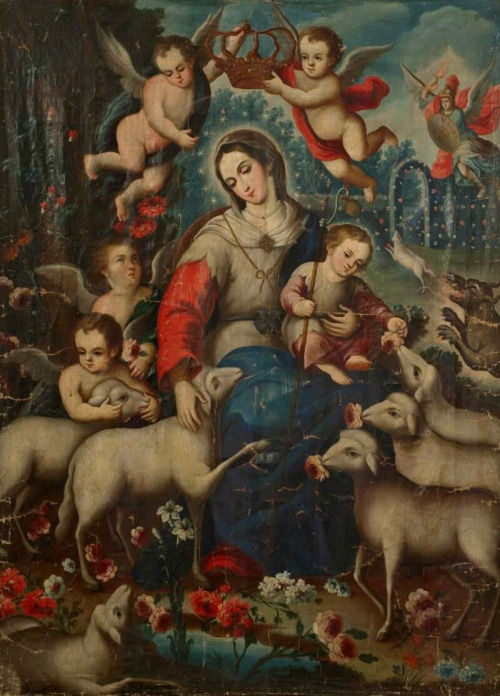Through the kindness of the late Sir Harry Downie, famed restorer and curator of Mission San Carlos Borromeo, the Archival Center for the Archdiocese of Los Angeles possesses an exceedingly rare imprint bearing the name of Fray Francisco Garcia Diego (1785-1846) who later became the proto-Bishop of Both Californias.
The twenty-two page publication, dedicated to the memory of D. Ygnacio Villaseñor, is an 1830 edition of the Novena a la Sña. Virgen Maria en la advocacion de la Divina Pastora, printed by Alexo Infante.
The background of the Novena itself is interesting and can be traced to Fray Isidro, who lived in an old Capuchin monastery at Seville. One night after the others had retired, the friar remained in chapel praying for an end to the growing corruption then prevalent among the local citizenry.
Suddenly, the Blessed Virgin appeared, in the guise of a shepherdess, with the Infant in her arms and a flock of lambs frolicking about her. Fray Isidro was instructed to inaugurate a devotion to the Divina Pastora as a means of winning sinners back to the service of Christ.
Bartolomé Estéban Murillo had lived at that monastery and one of his pupils, Bernardo German de Llorente, painted the apparition as it was described by Fray Isidro. From that time onward, veneration of the Divine Shepherdess began spreading throughout the Spanish empire.
Devotion to Our Lady under her title Divina Pastora was especially commom among the missionaries of Latin America. The home missions and retreats conducted by the Franciscans from the Apostolic College of San Fernando, for example, were traditionally given under the patronage of the Divine Shepherdess.
The copy of the Novena at Mission Hills was compiled and prepared for publication by Fray Francisco Garcia Diego, in 1830, while the young priest was serving as Commissary Prefect of the missions attached to the Apostolic College of Nuestra Señora de Guadalupe, Zacatecas.
The exquisitely-drawn portrayal of the popular Nuestra Señora de la Divina Pastora enhancing the otherwise unadorned publication is obviously adapted from a celebrated painting of La Divina Pastora by the Mexican artist, Jose de Paez.
Our Lady sits under a large tree, surrounded by seven sheep whose eyes resemble those of humans. Mary holds the crozier or pastoral staff in her right hand and the Infant Jesus in her left. The face of the virgin has an afflicted, somewhat Victorian charm. There are paintings of the Divina Pastora at Missions San Juan Capistrano, Santa Ines and Santa Barbara.
Following the general format of other novenas used in 19th century Latin America, the simply-structured collection of prayers honoring the Divine Shepherdess is arranged for recitation on nine consecutive days.
The Novena begins with an Act of Contrition, followed by an opening, and closing prayer which remains unchanged. Particular orations are then provided for each day. The devotion concludes with a trisagion and hymn, which very likely were chanted by the community.
The Novena was translated for inclusion in a volume of Fray Francisco Garcia Diego’s writings published in 1976, as part of the Catholic participation in the nation’s bicentennial observance.
Received in exchange for a fugitive volume from the historic mission library at Carmel, the only known extant copy of Fray Garcia Diego’s Novena is on permanent display in the Historical Museum attached to the Archival Center, along with a host of other memorabilia associated with California’s Catholic heritage.

